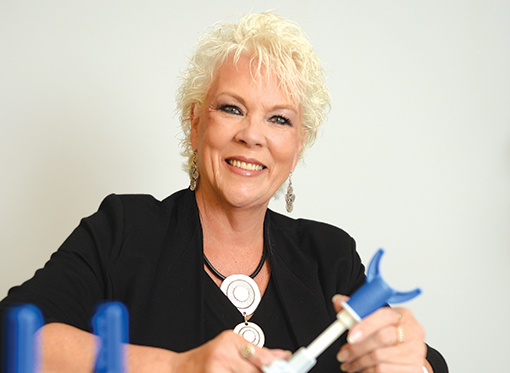Hearing a message of hope


Her strategy enabled her to run her own marketing company for more than two decades, and in 2010 she launched Mako Enterprises, an innovative niche manufacturer serving the concrete industry. On the side, she still runs a marketing consulting business, Purple Circle Marketing.
An accident first damaged her hearing, but the loss worsened over the years. Storjohann reached a point where hearing aids were no longer enough. Then she had coffee with Tom Rice, director of the Iowa Center for Higher Education in Des Moines, who had gotten a cochlear implant in 2014.
“After about a two-hour conversation he said, ‘You are crazy if you don’t get this,’ because it was so life-changing for him,” said Storjohann, who received a cochlear implant 18 months ago. “He was right — I’ve gotten my life back, basically. I’m not afraid to make phone calls, attend business gatherings. I can hear people again, and it’s just really exciting.”
Brad Nelson, who handles sales at Mako, had grown accustomed to helping Storjohann navigate meetings with prospective customers before she had the procedure.
“I’d say, ‘Keri can’t hear very well — you’ll notice me speaking up so you may want to also,’ ” Nelson said. “I’d repeat what was said and clarify, kind of walking her through the conversation the best I could.”
Having the procedure has been a 180-degree transformation, he said. “Now I can spend most of my time in the office and she can go out and sell, and she knows the most about this product because she developed it.”
Sarah Fugleberg, an audiologist with Iowa Ear Center, has worked with Storjohann throughout the entire process, which began with an assessment to determine if she was a candidate for the procedure. Although there’s an actual device that’s switched on about 30 days after the implant surgery, it’s often a slow and complex process for patients to learn how to process the new electrical signals their ears are sending the brain.
“We see the most change in the first six to 12 months,” Fugleberg said. “Some people can understand words on day one. Others it takes weeks or months.” Iowa Ear Center, which has been doing cochlear implants for the past eight years, completed its 200th procedure this past summer, she noted. University of Iowa Hospitals and Clinics is the leading cochlear implant center in the state.
Cochlear implants, which have been performed in the United States since the mid-1980s, are now FDA-approved for all ages over 12 months. The implants can enable someone who is totally deaf to hear for the first time, and the earlier they’re implanted, the better the chances are for developing normal speech and language, Fugleberg said. “For adults who no longer get benefits from hearing aids, the brain is wired for sound, so it knows how to handle these new signals.”
For people who have been deaf since birth, “we will have different expectations, because those pathways for sound are not wired,” she said. “So we don’t expect them to understand speech; it just helps them to hear sounds around them and in lip reading.”
Many patients are able to achieve the same level of success that Storjohann has had, although everyone’s experience is different, Fugleberg said. “We do see a lot of patients struggling with a hearing aid and then doing very well with a cochlear implant afterwards.”
For Rice, who first recognized his hearing loss in his late teens and had hearing aids by the time he was in his 20s, the technology enabled him to continue in his role at the time as associate provost and to move into his current position as director of UI”s Iowa Higher Education Center in Des Moines. His hearing loss prevents him from hearing any sounds in the higher pitches, which made understanding normal speech in group settings nearly impossible.
“For me, the benefits were instantaneous,” said Rice, who had a partial cochlear implant done in his right ear. “I began to hear things again like T’s and S’s, which are very high-pitched consonants.” He explained that with a word like “boat,” he at first didn’t actually hear the T sound he remembered, but now his brain has learned to fill in the new sound as a T.
Storjohann observed that most people really don’t realize how socially isolating it is to lose your hearing.
“There is a lot of fear that goes with it,” she said. “I’ll never forget the time I was at a social event. Somebody asked me a question, and I said, ‘Oh, yes, I attended Iowa State.’ And they looked at me like I had four eyes.”
The person had actually asked her where her office was located. “You just want to go crawl under a rock and hide,” she said. “Pretty soon you just don’t want to go to events anymore.”
Storjohann lost her hearing 40 years ago as a result of a head injury sustained in an auto accident, which gave her extreme tinnitus and hearing loss from damage to her inner ears. For many years, hearing aids improved her hearing, and advancing technology generally kept pace as her hearing worsened. But she reached a point where the hearing aids were amplifying noises without making sounds clearer.
By having the procedure done in just one ear, Storjohann’s hearing has been restored by about 75 percent, and the ringing in her ears has disappeared.
Before having the procedure done 18 months ago, she could hear 34 percent of conversations with both of her hearing aids when there was no background noise. That dropped off significantly when she was in public.
Retraining herself to hear was an amazing process — and a lot of work over the course of about a year.
“I would do a lot of books on tape and listen to the audio portion and just let my brain handle managing and marrying the beeps and sounds from the implant to the actual sounds in memory. It’s fascinating how it works — you can’t hear right away — you hear pings and beeps and buzzes, but it’s not really a sound.”
As an example, she was on her way home from the audiologist office one day when she recognized the sound of the turn signal in her car. “The really cool thing is that once your brain recognizes a sound, it always remembers what that sound is. It takes about a year before you feel you’ve finally heard everything. I heard the locusts again for the first time this year.”
The biggest revelation was realizing that she was able to hear her own voice again, which made communicating much less taxing. “It was exhausting — reading lips, interpreting what they said, and then concentrating on what I was saying and hoping I was saying it right,” she said. “I was just constantly exhausted because it takes so much energy.”
Since having her story featured recently on the local TV news, “I’ve had a lot of people write to me, saying, ‘Thanks for doing this — I thought I was going to lose my job due to my hearing loss but now I know I don’t have to.’ It’s just that message of hope. People don’t have to stop functioning in society or with their families because they can’t hear.”
Storjohann’s implant device — which required about a 90-minute surgical procedure to implant followed by months of work with an audiologist to retrain the ear to interpret the sounds — was covered by Wellmark Blue Cross and Blue Shield. She previously had been turned down by another insurer that said a cochlear implant wasn’t necessary.
“One of the things I would like to do is become an advocate with some of these insurance companies,” she said. “I was just beside myself — how can hearing not be necessary? I think there’s some reform that needs to go on in that respect. I think it’s more just spreading the word with those people that they can be helped.”
Cochlear implant facts
Nearly 188,000 individuals worldwide are fitted with a cochlear implant, according to the National Institutes of Health. In the United States, more than 41,000 adults and nearly 26,000 children have one.
In 1984, the Food and Drug Administration approved the first cochlear implant for use in adults ages 18 and older. Five years later, the FDA approved the first cochlear implant for use in children ages 2 and older. And in 2000, the FDA approved the implantation of children as young as 12 months of age for one type of cochlear implant.
NIH-supported scientists found that the benefits of the cochlear implant far outweigh its costs in children. A cochlear implant costs about $60,000 (including the surgery, adjustments and training). In comparison, the services, special education and adaptation related to a child who is deaf before age 3 cost more than $1 million.
A Gallaudet University study estimated Iowa’s deaf population to be around 115,000 in 2010, or approximately 4 percent of the state’s population, as reported by The Daily Iowan. Worldwide, there are nearly 70 million people considered deaf.
Business owner brings innovative product to concrete industry
The first time that Keri Storjohann attended the World of Concrete trade show, “I handed out my business card all day long, and (as a female) I got nothing but pushback,” she recalled.
The following year, although she was the company owner and CEO, she had business cards printed with the title “director of marketing,” and the men didn’t feel threatened to talk to her.
“I don’t care if they think I’m the secretary here,” she said with a laugh. “Focus on the product, how it can save you money, time and labor, and you’re going to get a better product out of it. So whatever they think my title is doesn’t matter.”
Her Johnston-based company, Mako Enterprises, specializes in making plastic components used by construction contractors to keep concrete level as it’s being placed. The company’s innovative product line fills a niche for more challenging jobs in which laser screeds and other high-tech leveling devices can’t be used.
Storjohann became intrigued with the original product while she was working with the company that had licensed the technology from her uncle. That company never succeeded in reaching the product’s potential, however. “So when it came off patent, there was really an opportunity to improve the shortcomings and make it bigger and better,” she said.
After 23 years in marketing, she launched Mako Enterprises in 2010, and in 2013 the company won the Most Innovative Product award at the World of Concrete. Storjohann now holds two patents and also has two patents pending.
Mako’s products are being used in a number of high-tech construction projects, ranging from an explosion-proof chamber for Boeing to the Hy-Vee regional warehouse under construction in Chariton and the new Kum & Go headquarters in downtown Des Moines.
Storjohann has a degree in technical illustration, and had a little bit of training in mechanical engineering before going into marketing. She doesn’t know how to run CAD, and instead does all her design drawings in PowerPoint.
“It’s more about creativity and seeing something and figuring out how to improve it,” she said. “You really don’t need a degree for that.”








